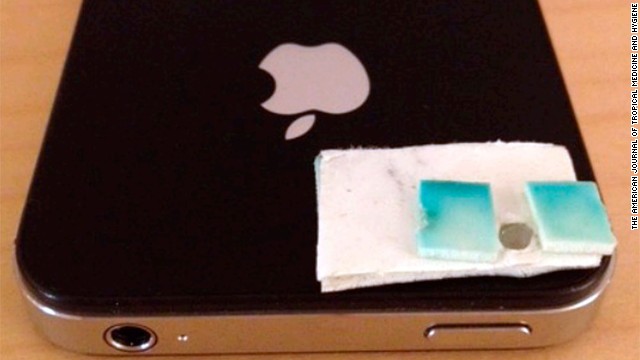An Apple product may help keep the doctor away in Tanzania.
In a discovery that provides doctors in remote areas with an alternative, scientists recently created a microscope using an iPhone, tape, flashlight and camera lens.
They then used it to diagnose intestinal worms in about 200 students in Pemba Island, off Tanzania's eastern coast. .
"To our knowledge, this is the first time the mobile phone microscope had been used in the field to diagnose intestinal parasitic infections," said Isaac Bogoch, an internal medicine specialist at Toronto General Hospital.
Bogoch, who conducted the study with colleagues, used his iPhone 4s.
However, he said, the approach can work with any smartphone that has a good camera and a zoom feature.
African markets are flooded with low-cost smartphones made by Chinese companies, some selling for as low as $80. With mobile phone growth skyrocketing in the continent, price-based competition is becoming vital to tap into the African market share.
From cell phone to microscope
To convert the phone into a microscope, scientists put double-sided tape over the iPhone camera lens. They then pierced a hole in the tape and centered a tiny $9 lens over the phone's camera lens.
Using a flashlight for illumination, they held up stool samples against the lens using the double-sided tape to hold slides in place, and studied them for intestinal parasites through the phone's screen.
Bogoch said they diagnosed 70% of the infections when compared with the results of a conventional laboratory microscope.
Convenience in remote areas
The scientists plan to tap into technology to make the results more accurate.
The mobile phone microscope is convenient because it allows testing for intestinal worms immediately and in close proximity with the patient, Bogoch and his colleagues wrote in their findings.
Innovative approaches that are portable and easy to assemble are vital in far flung areas, where labs are a rarity.
"The idea was to have a cheap solution in remote settings where equipment such as a microscope and electricity are not that easily available," said Benjamin Speich, a corresponding author and scientist at the Swiss Tropical and Public Health Institute.
Mobile phones are popular in Africa, where penetration rates remain high even in remote areas.
'Cheap solution'
Nearly 1.5 billion people -- 24% of the world's population -- suffer from helminth infections, commonly known as intestinal worms, according to the World Health Organization.
Most of those at risk are children, with most infections reported in Africa, the Americas and Asia.
Intestinal parasites are transmitted through contact with infected feces, which can lodge in the soil and spread though poor sanitation.
The study was published this week in the American Journal of Tropical Medicine and Hygiene. It was conducted by scientists from the United States, Switzerland, Tanzania and Canada.
First time in the field
This is not the first time scientists have converted a smartphone into a microscope, but past experiments have been limited to the lab, Bogoch said.
Two years ago, scientists at the University of California, Davis improvised a microscope using an iPhone.
They inserted a small ball lens into a rubber sheet, which they taped over the smartphone's camera.
At the time, researchers said they planned to validate the device for use in the field.

No comments:
Post a Comment